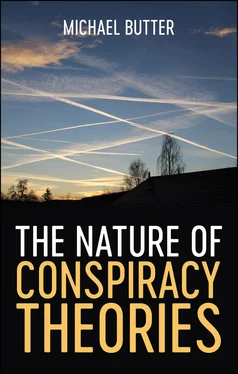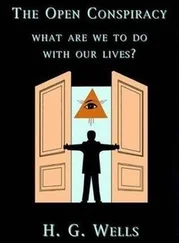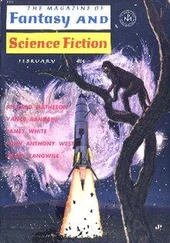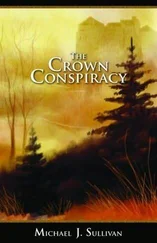Finally, superconspiracy theories are a conglomeration of event and systemic conspiracy theories. The Nazi theory of the global Jewish-Bolshevist conspiracy is a superconspiracy theory because it amalgamates two systemic conspiracy theories, the Jewish one and the communist one. The scenario presented by Robert W. Welch in The Politician is quite similar. He traces the global communist conspiracy all the way back to the Illuminati. Even more extreme is the conspiracy theory of the former footballer David Icke, which has many followers, mostly in the English-speaking world. Icke believes that the world is ruled by an elite class of reptiles who landed on Earth from outer space in prehistoric times and feed on the negative energy of human beings. In his view, these extra-terrestrial conspirators are behind almost every event and group around which conspiracy theories are woven. Here we have a particularly striking illustration of the idea that everything is connected. The huge scale involved – something that Welch’s and Icke’s theories share with those of Churchill and many others – is an important criterion for distinguishing imaginary conspiracies from real ones.
Conspiracy theories and real conspiracies
Up to now, I have omitted to discuss – at least explicitly – the question of whether conspiracy theories are true or not. At the same time, the wording I used at the beginning of this chapter – namely, that conspiracy theories ‘assert’ the existence of a plot – and, above all, the examples I have chosen so far, point to the fact that I, like the vast majority of academics, view them with a great deal of scepticism. That is not to say, of course, that conspiracies do not occur. From the Catilinarian conspiracy through to the by now widely documented attempt by the Kremlin to influence the 2016 American presidential elections, there have always been secret plots, and it is highly unlikely that this will ever change. But real conspiracies are very different from those that conspiracy theorists claim to have uncovered. And there has never been, to the best of my knowledge, a conspiracy theory as defined in the first part of this chapter that has subsequently turned out to be true.
The first difference between real conspiracies and conspiracy theories concerns the timescale of the alleged plot. According to the extremism expert Armin Pfahl-Traughber, the overwhelming majority of proven conspiracies are ‘relatively short-term projects with a concrete objective’, such as an assassination or a coup. By contrast, conspiracy theories nearly always posit a ‘much larger timeframe of conspiratorial action’ associated with far more ambitious but at the same time vaguer objectives ranging through to world domination. 8Accordingly, in order to achieve their sinister ends, the conspirators – real or imaginary groups such as Jews, communists, Illuminati or aliens – are generally alleged to have committed not just one offence, but a whole series of crimes over a period of years or sometimes decades, and in some cases even over centuries. In such scenarios, the perceived plot thus involves several generations of conspirators.
One might object that this argument disqualifies systemic and superconspiracy theories, but not event conspiracy theories which mostly relate to assassinations or coups or other clearly definable events such as the moon landing. Admittedly, it is easier to imagine such conspiracy theories ultimately turning out to be true. But even leaving aside the fact that most event conspiracy theories soon escalate into bigger scenarios, this is still very, very unlikely, since even event conspiracy theories differ from real conspiracies in one important respect: that of size.
Real conspiracies are generally the work of ‘a small group of people’, 9whereas conspiracy theories construct scenarios in which at least dozens, but usually far more people would have to have been involved. A gigantic deception like the staging of the moon landing in a TV studio, or the 9/11 attacks, which unfolded live before the eyes of the world, would require hundreds, if not thousands of insiders and accessories. Against this, critics sometimes contend that, even in the case of an event on the scale of 9/11, it only takes a small number of conspirators acting under false pretences to persuade all the other parties involved – the air defence pilots who failed to intervene, the agents who quickly leapt on the trail of al-Qaida, and many others besides – to do their bidding. But this argument is not conclusive because the involuntary accomplices would discover after the event, if not before, what they had unwittingly helped to engineer, in which case they too would become accessories to the conspiracy.
As the philosopher Brian Keeley argued some twenty years ago, the large number of insiders required by such scenarios militates against the existence of these plots due to the virtual impossibility of keeping them secret. 10Indeed, the mathematician David Grimes recently went as far as to develop a model to calculate the point at which a given conspiracy would logically become public on grounds of size alone. According to his calculation, the staging of the moon landing could only have been concealed for a maximum of four years. 11This may be more of a mathematical exercise than an adequate description of reality, but the fact remains that no one has so far come forward to confess their role in the faking of the moon landing, the assassination of Kennedy or the 9/11 attacks, or to accuse others of making them an unwitting accomplice in those acts. Journalists who have defected from what conspiracy theorists call the ‘mainstream media’ to the conspiracist camp sometimes complain of having been instrumentalized in order to spread lies, but they invariably fail to provide any evidence for this, or for any specific plot – a further indication that such conspiracy theories belong to the realms of fantasy.
Another argument against the existence of such large-scale conspiracy scenarios is likewise mentioned by Keeley: ‘The world as we understand it today is made up of an extremely large number of interacting agents, each with … its own set of goals.’ 12For a conspiracy to be successful, all parties would have to set aside their own interests and devote themselves entirely to the service of the conspiracy, something which is very unlikely, if not impossible. In his excellent introduction to the logic of conspiracy theories, the social psychologist Jovan Byford develops this idea a little further. According to him, a strong argument against the existence of conspiracies as claimed by conspiracy theorists is that there is in reality not one huge conspiracy but many competing smaller conspiracies. Different groups do not, as conspiracy theorists maintain, act in concert, but pursue different and often contradictory aims. Consequently, there is no single group quietly orchestrating events over a long period of time, but a variety of factions – camps within a government, rival intelligence services within a country, mutually hostile departments within the same intelligence service, and so on – which are all bent on implementing their own agenda, if necessary by conspiratorial means, and which regularly get in each other’s way. For this reason, Byford concludes, it is nonsensical to assume that one group could seriously control the destiny of an institution, country or indeed the entire world over many years. 13
Perhaps the strongest argument against conspiracy theories, however, is that they are rooted in a view of human agency and history that has been radically challenged by the modern social sciences. Conspiracy theories are based on the assumption that human beings can direct the course of history according to their own intentions – in other words, that history is plannable. They credit conspirators with the ability to control the destiny of a country or even the world for years or decades at a time. Indeed, they often understand history as a series of plots by one or various groups. Consequently, they have a fundamentally different view of the world from that of psychology, sociology or political science. According to psychology, the ego is not master in its own house, as Sigmund Freud famously put it; in many cases, we don’t know exactly what we do or don’t want, and find it accordingly difficult to act on our intentions. But even if we did always know our own desires, we still couldn’t achieve them, since social systems – as sociology and political science have shown – have a life of their own and generate effects that no one intended.
Читать дальше












